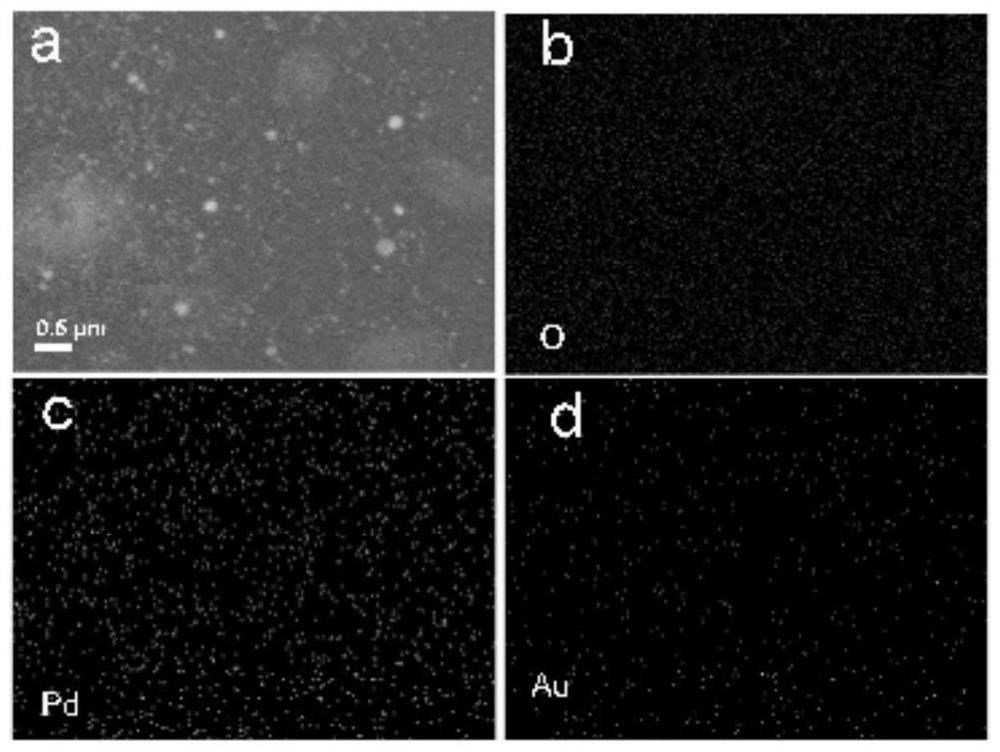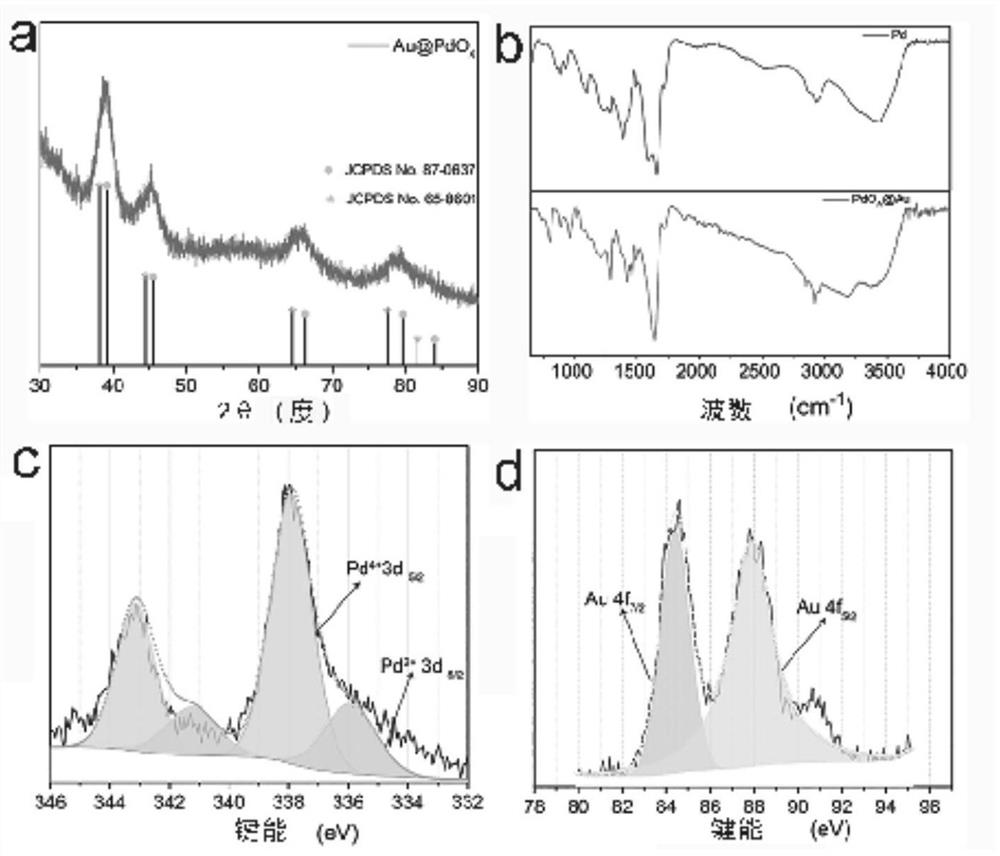Flower-like palladium oxide-gold nano composite material and preparation method as well as application thereof
A composite material, palladium oxide technology, applied in the field of nanomaterials, can solve the problems of no bimetallic nanomaterial synthesis and application reports, and achieve the effects of easy operation, enhanced SERS activity, and simple process
- Summary
- Abstract
- Description
- Claims
- Application Information
AI Technical Summary
Problems solved by technology
Method used
Image
Examples
Embodiment 1
[0039] Add 16 mg of Pd(acac) sequentially to 10 mL of N,N-dimethylformamide (DMF) 2 , 1 mg of citric acid, 60 mg of cetyltrimethylammonium bromide (CTAB), and 20 mg of polyvinylpyrrolidone (PVP) were mixed and stirred for 1 h to obtain an orange-red liquid.
[0040] Then transfer to a 25mL flask and add 100mg of tungsten hexacarbonyl (W(CO) 6 ) heated and stirred at 80 degrees Celsius in an argon atmosphere for 1 hour to obtain blue hexagonal palladium nanosheets, such as figure 1 As shown in figure a.
[0041] The volume ratio of acetone and ethanol is 8:2 to purify palladium.
[0042] Dissolve the purified palladium in 2mL of ultrapure water to obtain a palladium nano-solution of 1mg / mL, take 500 μL of palladium nano-solution and 250 μL of 5mM chloroauric acid HAuCl 4 Stir for 5 minutes to obtain flower-shaped palladium nanogold.
[0043] The characterization of the nanomaterials prepared in this example can be seen Figure 1-3 .
[0044] figure 1 Figures of each prod...
Embodiment 2
[0051] Add 26 mg of Pd(acac) sequentially to 15 mL of N,N-dimethylformamide (DMF) 2 , 5 mg of citric acid, 90 mg of cetyltrimethylammonium bromide (CTAB), and 40 mg of polyvinylpyrrolidone (PVP) were mixed and stirred for 1 h to obtain an orange-red liquid.
[0052] Then transfer to a 25mL flask and add 120mg of tungsten hexacarbonyl (W(CO) 6 ) was heated and stirred at 100 degrees Celsius in an argon atmosphere for 0.5 hour to obtain blue hexagonal palladium nanosheets.
[0053] The volume ratio of acetone and ethanol is 1:0.3 to purify palladium, wherein ethanol is 95% ethanol by volume.
[0054] Dissolve the purified palladium in 2mL of ultrapure water to obtain a palladium nano-solution with a concentration of about 1mg / mL. Take 500 μL of palladium nano-solution and 150 μL of 5mM chloroauric acid HAuCl 4 Stir for 8 minutes to obtain flower-shaped palladium gold nanoparticles.
Embodiment 3
[0056] Add 20 mg of Pd(acac) sequentially to 5 mL of N,N-dimethylformamide (DMF) 2 , 10 mg of citric acid, 50 mg of cetyltrimethylammonium bromide (CTAB), and 30 mg of polyvinylpyrrolidone (PVP) were mixed and stirred for 1 hour to obtain an orange-red liquid.
[0057] Then transfer to a 25mL flask and add 100mg of tungsten hexacarbonyl (W(CO) 6 ) was heated and stirred at 80 degrees Celsius in an argon atmosphere for 1 hour to obtain blue hexagonal palladium nanosheets.
[0058] The volume ratio of acetone and ethanol is 1:0.1 to purify palladium, wherein ethanol is 95% ethanol by volume.
[0059] Dissolve the purified palladium in 2mL of ultrapure water to obtain a palladium nano-solution with a concentration of about 1mg / mL. Take 500 μL of palladium nano-solution and 100 μL of 5mM chloroauric acid HAuCl 4 Stir for 15 minutes to obtain flower-shaped palladium nanogold.
PUM
| Property | Measurement | Unit |
|---|---|---|
| Concentration | aaaaa | aaaaa |
| Particle size | aaaaa | aaaaa |
Abstract
Description
Claims
Application Information
 Login to View More
Login to View More - R&D
- Intellectual Property
- Life Sciences
- Materials
- Tech Scout
- Unparalleled Data Quality
- Higher Quality Content
- 60% Fewer Hallucinations
Browse by: Latest US Patents, China's latest patents, Technical Efficacy Thesaurus, Application Domain, Technology Topic, Popular Technical Reports.
© 2025 PatSnap. All rights reserved.Legal|Privacy policy|Modern Slavery Act Transparency Statement|Sitemap|About US| Contact US: help@patsnap.com



